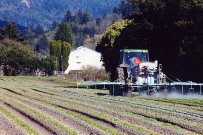
The South Fork Smith River below the private 148-acre property protected by Siskiyou Land Conservancy. Photo by Greg King.
Many supporters of Siskiyou Land Conservancy are aware that the organization grew out of the Smith River Project. Siskiyou Land Conservancy now serves five counties in Northwestern California, but our commitment to the Smith River has never waned.
Recently the Siskiyou Land Conservancy board of directors opted to ramp up our protection efforts for the Smith. The reasons for this are many. Most pressing is that California’s salmon and steelhead populations are facing an extinction crisis, and the Smith River holds the promise of being one of the few streams that may weather the disaster.
Disappearing Salmon
According to fisheries expert Peter Moyle and the U.C. Davis Center for Watershed Sciences (2008), two-thirds of the state’s salmon and steelhead runs are in danger of disappearing over the next 50 to 100 years. The extinction crisis is generally moving from south to north. At the apex of this reach, in Del Norte County, is the glorious Smith River: 400,000 acres of the best remaining fish habitat on the West Coast.
Yet the Smith River faces significant threats such as development on private lands, clear-cutting and herbicide use by a major timber company, and pesticide inundation on farmlands surrounding the Smith River estuary.
Analysis: The State of the Smith River
At the same time, little is known about fish runs in the Smith. No broad overview of the Smith River exists, though we do know the Smith is a “seedbank” whose salmon and steelhead “strays” can recolonize recovering streams up and down the Oregon-California coast. Which makes protecting the Smith River more crucial than ever.
This year Siskiyou Land Conservancy began creating an important overview: The State of the Smith River. Complementing this research are two habitat restoration projects on Smith River properties protected by Siskiyou Land Conservancy.
The Smith River is a keystone watershed. Moyle insists that state and federal governments should “Provide immediate additional protection to ‘salmon strongholds’ where salmonid diversity is high and habitat conditions are still reasonably good, such as the Smith River. …”
Key to providing such protection will be a greater understanding of the Smith River as a whole. How are fish doing in the Smith? Where are weak areas in need of restoration, and strong areas requiring greater protection? How can we best sustain the Smith’s crucial salmon runs? Siskiyou Land Conservancy will attempt some answers in The State of the Smith River.
This is no small task, and our project is already underway. Since the organization was founded, in 2004, Siskiyou Land Conservancy has been dedicated to protecting the Smith River. Currently SLC Research Associate Vanessa Vasquez and Program Director Greg King are gathering information from current and past studies, and from sources such as recent salmon counts; past and ongoing research by the California Department of Fish and Game, the National Marine Fisheries Service, Humboldt State University, and the state and national park systems; anecdotal fish counts by local anglers; and tribal histories. We are also culling from 10 years of work by Siskiyou Land Conservancy and its predecessor the Smith River Project.
Restoration on the North Fork Smith River

The North Fork Smith reaches from the Kalmiopsis Wilderness in Oregon down to the town of Gasquet along the Middle Fork Smith River. Siskiyou Land Conservancy protects 80 acres of rare plant habitat at the confluence of Stony Creek and the North Fork Smith River. Stony Creek is the North Fork's only roadless tributary. Photo by Greg King.
In spring 2011 Siskiyou Land Conservancy, with the cooperation of the U.S. Fish and Wildlife Service and the California Department of Fish and Game, will begin a restoration project to protect 80 acres of rare plant habitat owned by SLC at the confluence of the North Fork Smith River and Stony Creek, both of which support salmon and steelhead. This is one of the most beautiful and biologically important private parcels on the North Fork, indeed on the entire Smith River: rare plant habitat at the gateway to 1 million acres of wild lands that stretch well into southwest Oregon.
When Siskiyou Land Conservancy purchased this property in 2004, U.S. Fish and Wildlife Service plant biologist Dave Imper called the acquisition “one of the most significant conservation milestones over the past several decades in northwestern California.” Yet Imper is concerned that a lack of natural wildfire has allowed shrub species to overtake important rare plant habitat on the parcel. Our restoration work to thin some of the brush will be accompanied by a survey of the rare plants in the area.
Restoration on the South Fork Smith River

About half of the 148-acre riverside parcel that Siskiyou Land Conservancy protects on the South Fork Smith river is pristine. Photo by Greg King.

Much of the other half of this parcel consists of thick regeneration in need of thinning to improve forest health and prevent wildfires. Photo by Greg King.
At the other end of the Smith River, on the beautiful South Fork, SLC holds a conservation easement on a 148-acre riverside parcel. This land features the easternmost redwoods on the Smith River and the largest privately owned alluvial flat on the South Fork. Half of the parcel is pristine, but the other half is dense with small trees and brush that grew up after logging 30 years ago.
Siskiyou Land Conservancy is working with the landowner and state and federal agencies to improve forest health and reduce fire danger on up to 23 acres of this property. This project complements the adjacent Big Flat Vegetation and Fuels Management Project, a current effort by the Smith River National Recreation Area. SRNRA officials have voiced support for the SLC project, as it could prevent a wildfire from spreading from the private land to old-growth forests on adjacent public lands.
To donate to this work send your contributions to:
Siskiyou Land Conservancy
P.O. Box 4209
Arcata, CA 95518
Note “Smith River” on your check.
Thank you!


